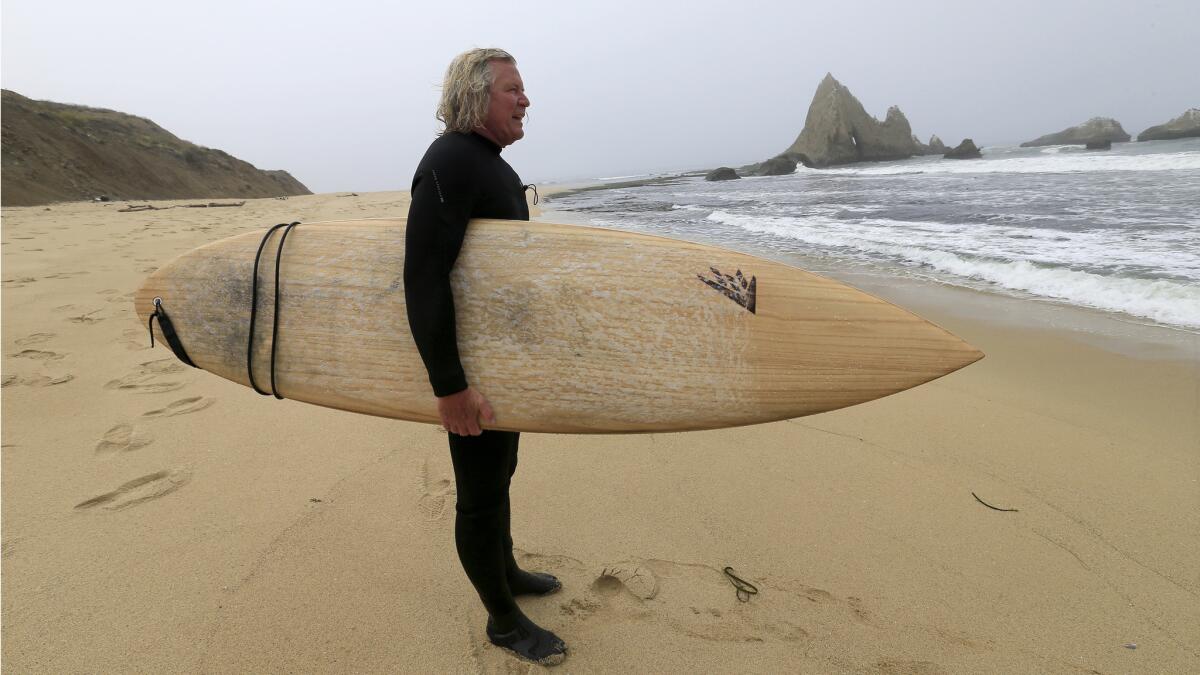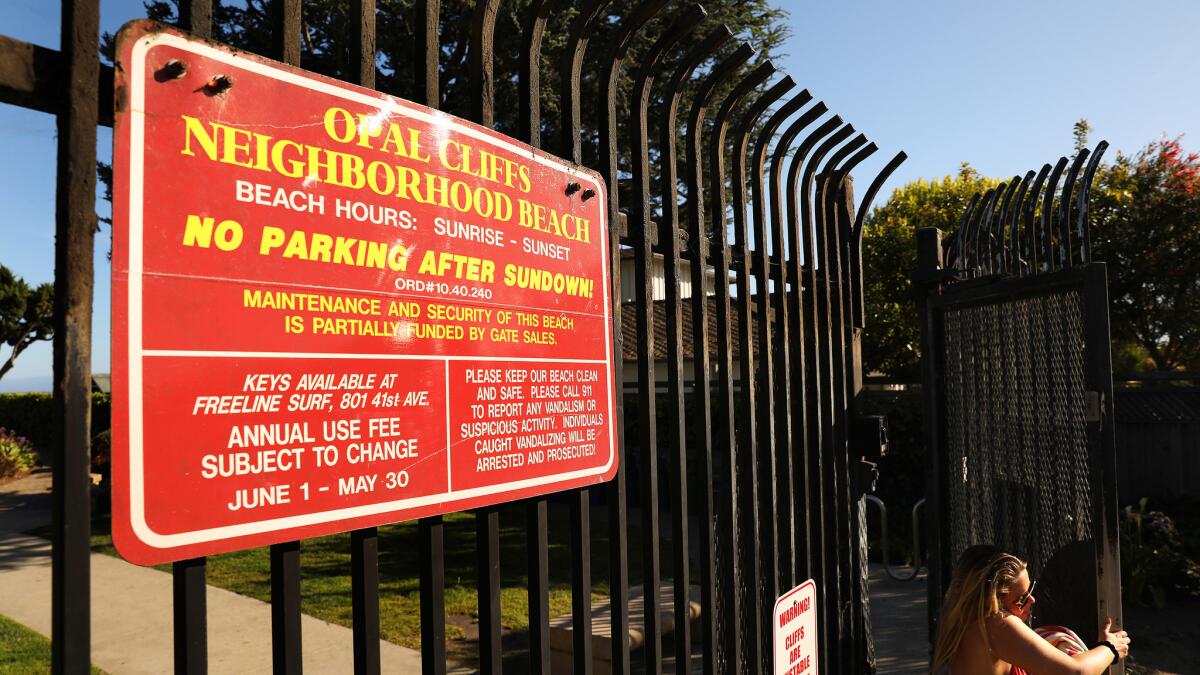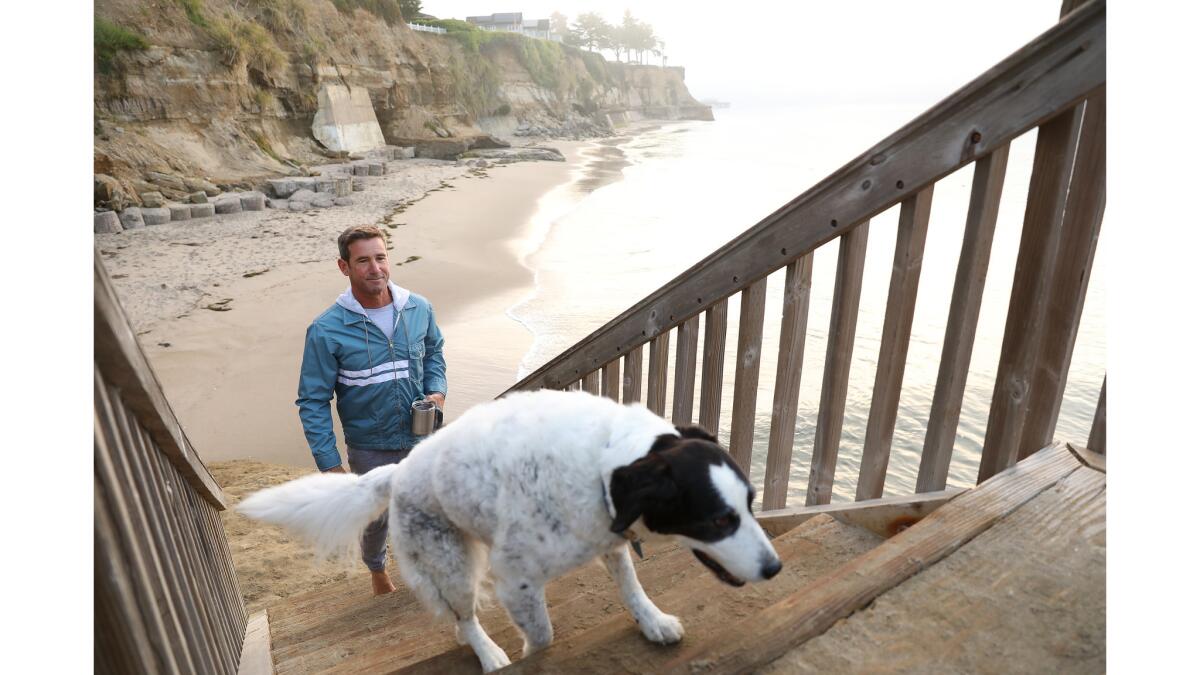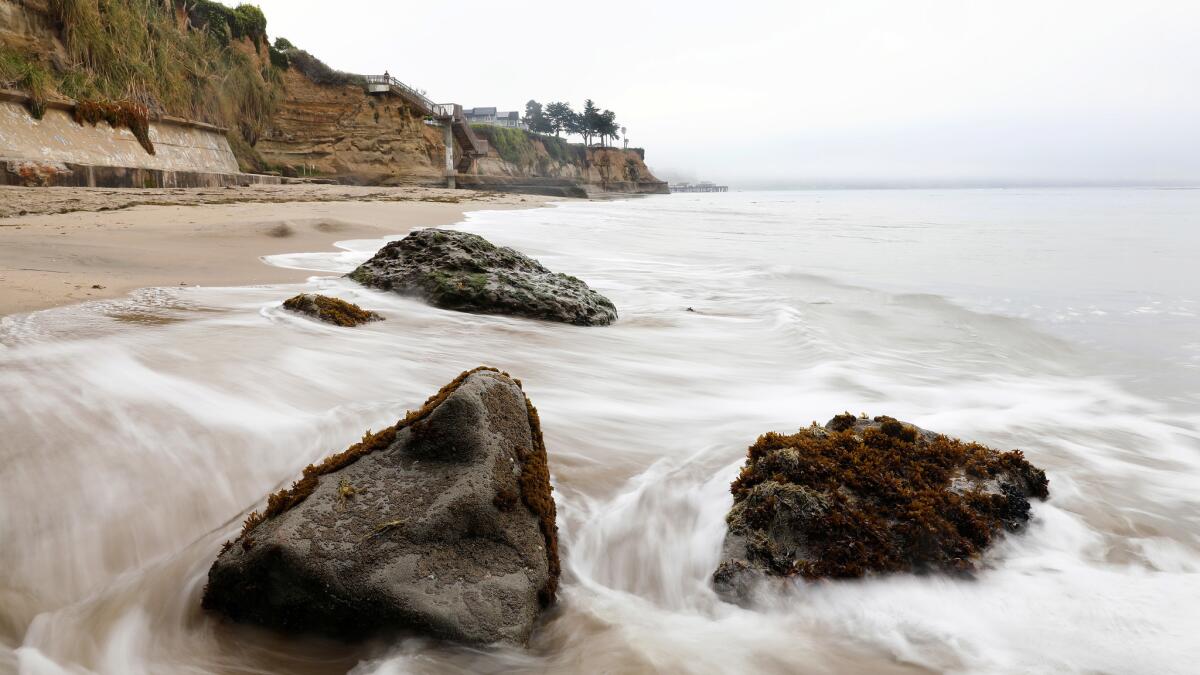Column: A legendary protector of California’s beaches is now branded a traitor over access fight

- Share via
Reporting from SANTA CRUZ — If and when California builds a Hall of Fame for the state’s heroes of coastal protection and beach access, Mark Massara will be one of the first inductees.
Massara — surfer, attorney, fighter — is a blond, sun-dipped California original with a voice like sandpaper on a surfboard. His list of crusades and victories — against the Hearst Corp.’s plans to annihilate the Central Coast, against a 14-story liquid gas terminal off the coast of Malibu, against Humboldt County pulp mill polluters, and on and on and on — would more than fill all my space here today.
Given this history, lots of people are wondering why Massara has represented developers and alleged Coastal Act violators in recent times, and why he is the attorney behind an attempt by residents of a Santa Cruz neighborhood of multimillion-dollar homes to keep the gate to a public beach closed. Opal Cliffs Beach, also known as Privates Beach for its occasional nude sunbather, is loved by local surfers, who tend to be a territorial breed.
“You could call a hundred people and half of them think I’m a traitor,” Massara himself admitted.
But he claims everybody’s got it wrong.

On Wednesday, I went to the beach to talk to locals and two staffers who work for the California Coastal Commission. But let’s start with a review of recent stories on the controversy by my colleague Rosanna Xia.
In 1949, residents of the Opal Cliffs neighborhood got Santa Cruz County’s approval to establish their own recreation district to manage a sweet cove just up the coast from Capitola. In 1963, reports of vandalism led to the locking of the gate to the beach and limiting access to keyholders who paid $1 a year (the annual fee is now $100).
In 1981, the California Coastal Commission endorsed the idea of a permit for a fence and gate. Ten years later, the commission recorded a deed allowing the beach park to charge whatever it deemed necessary to continue its operation.
But as the Coastal Commission’s Central Coast Director Dan Carl and Northern California Enforcement Supervisor Pat Veesart explained to me Wednesday at Opal Cliffs, an examination of records revealed the 1981 permit was never activated and the tentative approval expired a year later. In 1991, the commission erred in thinking a permit existed, and offered a conditional extension of it, they said.
“Staff made a mistake,” Veesart said. “But the public should not be punished for that.”
Carl and Veesart argue that the park district has no permit for what is now a 9-foot-tall wrought iron gate with a guard stationed at the entrance, nor does it have permission to charge $100 to anyone who wants a key.
They say Massara’s clients are essentially using a public beach as a private club, and Opal Cliffs is the only place in California where there’s a fee to use the beach. That stands as a violation of the Coastal Act that Massara has spent decades interpreting and defending in the public interest, which leaves his critics wondering if his motive is to look out for surfer buddies or rake in lobbying fees or both.
“I am surprised and I am disappointed in Mark’s hypocrisy in so many ways,” said Carl, a longtime Massara ally on numerous issues.
To which Massara says, essentially, who are you calling a hypocrite?
“As long as I’m being their cheerleader, it’s all great,” he said, but now he’s taking on the commission, so he’s a villain.
It wasn’t long ago, Massara noted, sticking with the hypocrisy theme, that the commission surrendered in its long-running fight to win easier public access to Hollister Ranch beaches on the Central Coast.
“To me, what’s really interesting here is that they don’t want to take on anything they think is a difficult fight, but they’re trying to squash the little guy,” Massara said.
The little guy, in his mind, is an Opal Cliffs Recreation District that has managed and preserved a great asset since long before the Coastal Commission existed. Massara accuses the commission of trying to put the district out of business by denying it the right to charge the fees needed to manage its operation.
The two sides had considered proposals to keep the gate open during daylight hours, and Massara said his clients might be willing to install a lower fence and maybe charge a $2 to $5 day-use fee for those who can’t pay for a $100 key. The district is allowing free entrance this summer, and Massara argues that his clients are all about enhancing beach access, not restricting it. But last month, Massara and his clients pulled out of scheduled negotiations, and the matter could be headed to court.

So now let me take you back to the beach.
When you arrive at the entrance, you don’t find a welcome mat, or any outward sign that the Opal Cliffs Recreation District is trying to enhance access. The fence is imposing, the heavy iron gate is closed and a guard — the district calls them ambassadors — is on duty.
If you didn’t know the background or state law, you’d assume this was a private beach and keep moving, and excuse me, but I have trouble believing that’s not the intended message.
When I pushed the gate open and walked in with Veesart and Carl, we weren’t questioned, but the guard later told me he can “sense a vibe” with visitors who might not respect the property.
Maybe, or maybe not, and there’s nothing in the Coastal Act suggesting you can be shooed off a beach if someone has a vibe about you.
A retiree named Pat was walking his poodle inside the gate. He said he’s a nearby resident who’s been using the beach for over 40 years. He supports the fee program and he likes to see the gate controlled to keep out anyone who might vandalize or trash the beach or use it to party, all of which has happened before.
I understand that perspective, but again, we’re talking about a public park and a public beach. Pat said he understood that full public access was a Coastal Commission objective, but he wondered why Opal Cliffs couldn’t be an exception, given its history of fences and fees.
“I guess I’d flip it around and ask why not do the same thing on every beach in California?” Veesart said.
Veesart answered his own question, explaining that the commission has a legal mandate to make all beaches accessible.

As we spoke, a fisherman made the trek up the stairs from the beach with his toddler son strapped to his back, fast asleep. Jeff Singson was carrying a 23½-inch halibut he’d just caught, and he said he had mixed feelings about the gate and the fees.
Singson said he appreciates how well-managed and pristine the beach is, thanks to the gate and the fees. But as a teacher on a tight budget, he hasn’t always purchased the $100 key. He said he’s been turned away at the gate, which didn’t seem fair to him as a taxpaying county resident.
Two summers ago, Massara and I met just up the coast at Martins Beach, where billionaire Vinod Khosla has been fighting to restrict access across his private property to a stretch of sand with a long history of public access. Massara is one of the people who has led the charge to open the gate there. On that visit, I played devil’s advocate in asking Massara why the public needed access to Martins Beach with so many others available up and down the coast.
Massara was eloquent and passionate, as he has been so many times over the decades, describing what is sacrificed “each time a beach is lost to the public.”
“At Martins Beach,” he said, “it’s important that future generations can see what a treasure this is.”
The history and the details are different at Opal Cliffs, but for me, the same ideal applies. The Opal Cliffs Recreation District may have done a nice job of managing the beach for many years, but that’s been partly by limiting who can visit what is a public asset, not a private one.
Open the gate during daylight hours. Collect donations for beach maintenance and supervision. Access and preservation don’t have to be mutually exclusive, and by the way, there’s not enough parking to accommodate the masses at Opal Cliffs, unwashed or otherwise.
Up and down the California coast, there have been and there always will be subtle and shameless attempts to block access. But voters rose up more than 40 years ago to fight back, and the eventual result was a Coastal Act that aims to preserve the coast, limit development and maximize access, regardless of ability to pay.
The guiding principle is this:
In California, no beach is anyone’s, it’s everyone’s.

Get more of Steve Lopez’s work and follow him on Twitter @LATstevelopez
More to Read
Sign up for Essential California
The most important California stories and recommendations in your inbox every morning.
You may occasionally receive promotional content from the Los Angeles Times.











